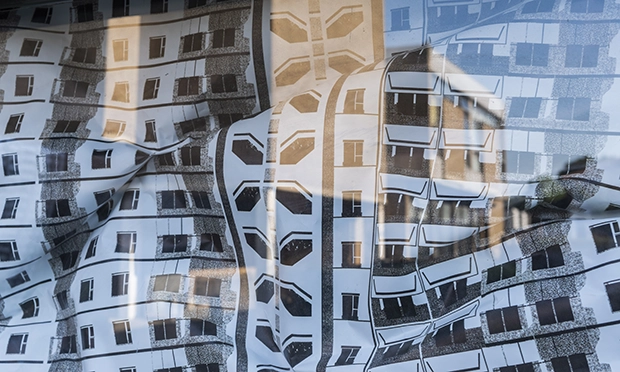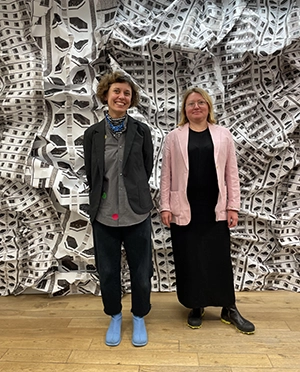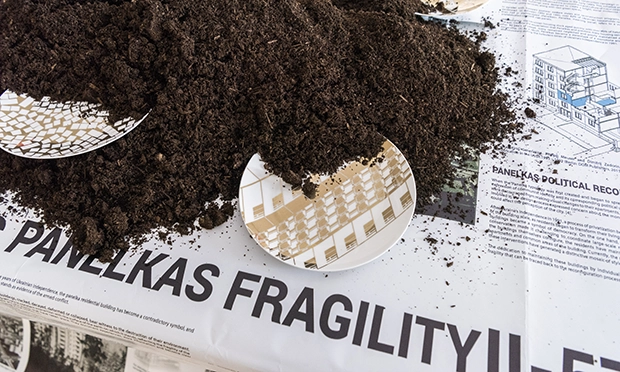‘Home is a human right’: Ukrainian artists behind recent Hackney exhibition on the beauty of Brutalist housing

An artwork from Fragile Brutalism. Photograph: Sean Pollock
An exhibition last month saw two Ukrainian artists explore how social housing can be used by people of different nationalities to share notions of what ‘home’ means.
Fragile Brutalism was at the heart of the council’s short season of events that showcased the work of Ukrainian creatives in Hackney.
The display showed off the Brutalist housing-block style found in both the high-rises of the De Beauvoir Estate and the flats of Kyiv, Ukraine’s capital.
Architect Elena Orap and graphic designer Dasha Podoltseva created it as a response to this year’s London Festival of Architecture theme of ‘in common’ before installing it across three sites in Hackney.
Brutalist types of buildings are common designs for social housing in many countries.
Dasha said: “They look almost the same. A perfect match. Very, very similar.”
The exhibition included billboards and window displays with graphics evoking the uniformity and brutishness of these buildings.
It reframed the utilitarian designs in a colourful, beautiful new way.

Dasha and Elena. Photograph: Hackney Council
Alongside the exhibits was a discussion event and a Ukrainian food and music gathering that saw people find common ground and express the trauma of being uprooted.
Elena said: “It was interesting to hear the similarities and differences in homes and to hear people discuss their homes. It was a pleasure to meet Ukrainians in London. It was super nice.”
The artists also hosted a poster-making session about what home means.
Dasha said: “People wrote that home is human rights, and humanity. People miss their homes, want to go back and want their homes to be restored.”
Through art, Ukraine has often grappled with the complications of the widespread tower blocks built under Soviet rule after the Second World War.
Elena and Dasha found inspiration in Jonathan Ben-Shaul’s 2021 film, What should we do with these buildings?, which was screened as part of Fragile Brutalism.
For them, it seemed this question about the buildings’ legacy had taken on a new importance in the context of the ongoing war in Ukraine.
Dasha said: “We have lots of ruining of buildings by Russia in Ukraine, so it’s a question about that. But also, it’s to question whether we should rebuild them as they were, or redesign them for future estates.
“This is a common question for the UK and Ukraine about the modernist legacy in architecture.”
Elena said: “Often the discussion is about how we can end the war before discussing reconstruction and reconfiguration. We cannot predict what circumstances we will face after the war.
“The exhibition was to ask the question, rather than to answer it.”

An installation at the exhibition. Photograph: Sean Pollock
Fragile Brutalism is just one of many displays by the pair over the last five years that have covered social housing as a theme.
Their interest was borne out of their own stories of growing up in the tower blocks, and a strong belief that sharing these experiences are important.
Dasha said: “We are trying to find beauty and love in these prefab houses and somehow show the beauty to others.”
Elena said: “Eighty per cent of our prefab housing is built in the 70s or 90s. You can find these houses in every district of Kyiv, in small towns and big cities.”
The opportunity for the exhibition came about thanks to the artists’ collaboration with Hackney Council arts and culture coordinator Lucy Mcmenemy and Johannes Novy from Westminister University, who helped with research and curation.
The display purposefully coincided with the reveal of new redevelopment plans for the De Beauvoir Estate, which were presented by the hosts of the exhibition, Stephen Taylor Architects.
There are plans for 189 new homes at five sites across the estate, with 50 per cent available for social rent and shared ownership.
